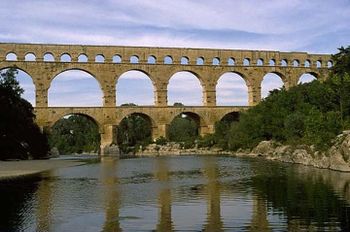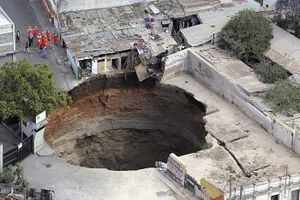Aqueduct
“An aqueduct is the last refuge of the unimaginative.”
“On second thought, please don't write that down. It wasn't very good.”
An aqueduct is a term for a bridge or viaduct that transports water across a gap. The aqueduct was an important invention because of water's natural tendency to flow to the highest possible point on the landscape, and, as such, allowed humans to easily obtain water from mountaintops. Prior to the invention of the aqueduct, water had to be ferried down from mountains manually, via mountain goats.
Although aqueducts have many important functions, including irrigation, looking antiquey, and providing the ability to wet one's white T-shirt in order to more successfully flirt with boys even when miles from the beach, they also have some drawbacks. For one, they have a tendency to ruin a perfectly good bridge.
Examples of bridges ruined by aqueducts are myriad, but one of the most notable took place in the year 122 CE, when Roman merchant Pelargius Whammo achieved some historical fame by attempting to lead a trade caravan over a gorge when the bridge was suddenly converted into an aqueduct. This led to the invention of the Slip 'n Slide, but, slightly more unfortunately, caused thirty merchants and seventy-five oxen to plummet to their deaths.
An additional drawback of the aqueduct is that it tends to become a symbol of imperial oppression, prompting slaves to scream "Smash the aqueduct!!" and then subsequently attempt to smash the aqueduct. Fortunately, should the slaves successfully smash the aqueduct, the mess is nothing that Brawny paper towels can't take care of. The slaves, on the other hand, will need to be hanged, and that requires a good, strong rope and something to hang them from, such as another aqueduct.
History
Aqueduct is a portmanteau of the words aqua, meaning "water," and duct, meaning "tape." Although this etymology may be confusing today, it is important to keep in mind that the ancient Romans constructed most of their bridges out of tape. This policy was reversed only after Julius Cæsar's first attempt to cross the Rubicon ended in a tangle of sticky Roman man-flesh.
Prior to the invention of the aqueduct, ferrying water into a city was a complex, expensive process. Water could be carried down from the top of a mountain on baskets strapped to goats, but could be taken no further, because goats refuse to walk on flat ground. This would leave the water several miles from the city center, where it was useless for washing grapes or washing dates or washing figs. In fact, it was useless for washing most kinds of fruit, with the exception of pomegranates, which are self-cleansing.
The Romans' original solution was to have slaves carry the goats into the city. Unfortunately, the number of slaves whose skulls were caved in by goat kicks proved unacceptable, because it diminished the pool of citizens willing to volunteer to be slaves. Thus, a secondary solution was devised, whereby the slaves would form a long line and pass handfuls of water to one another. Unfortunately, very little water reached the city using this method. Roman authorities concluded that the slaves were stealing it, and sentenced many of them to death by having their skulls caved in by goat kicks.
Finally, the Romans hit upon the solution of constructing a long stone bridge. The prototype bridge initially failed because it was completely flat, and water requires either an incline or a decline in order to flow, as dictated by Newton's laws of inertia. Fortunately, the middle section was lowered several feet by slaves attempting to smash the aqueduct (which, at the time, they knew as "the unidentified stone symbol of imperial oppression"), allowing the water to flow freely into Rome. From then on, all aqueducts would be constructed in their characteristic "V" shape. There were also experiments with "Y"-shaped aqueducts, but they were eventually considered unnecessarily tall.
Modern Implementations

In modern times, aqueducts have become even more crucial, especially after the invention of hygiene, which requires water to be present in individual homes.
Shortly after hygiene was invented during the Lower Middle Ages, citizens became disgruntled by the fact that their water contained no pressure; it would simply seep into the house and all over the floor, forcing women to mop for as many as twenty hours a day. Thus, the angle of decline of aqueducts was increased, and deep channels were dug so the water would flow several hundred feet underground before beginning its incline back to the surface. This caused the water to erupt from the ground underneath homes at a high velocity, which, properly impeded, would produce the illusion of pressure.
This innovation led to the invention of the reverse toilet, which, when flushed, would attempt to dispose of liquid and solid waste by shooting it up through a hole in the ceiling into outer space. The reverse toilet would prove unpopular, mostly because waste usually failed to break through the Earth's gravity well and generally landed only a few centimeters from its point of origin. It was thus discontinued only several centuries later.
Similarly, engineers of this time period developed the reverse shower, which was also unpopular, because of its tendency to propel bathers up to a dozen meters into the air. However, the reverse shower is today known as the father of the sprinkler. It is unknown who the mother of the sprinkler is.
Also unpopular and destined for the wastebin of history was the reverse lawnmower, which attempted to shove grass back into the ground. Although this invention was not strictly dependent on advances in aqueduct technology, it was invented specifically so that historians could later complain about three inventions that worked exactly the opposite way that they were probably supposed to: complaints always sound more impressive in threes.
For a time, the unpopularity of these inventions threatened to cause the public to lose faith in aqueducts, and some swore to abandon hygiene altogether. Fortunately, in the mid-19th century, Italian plumbers invented the pipe, which greatly relieved them, because prior to this invention, "plumber" was a useless profession and their parents had been disappointed in them for choosing it.
The pipe was initially not without its own problems, including lead poisoning and the emergence of walking mushrooms and giant piranha-like plants that threatened to destroy the population of Italy. However, refinements in plumbing and flamethrower technology eventually resolved these problems. Eventually, metal pipes would replace stone aqueducts throughout most of the civilized world, with the notable exception of Estonia, whose citizens preferred stone because it reminded them of their country's name.


